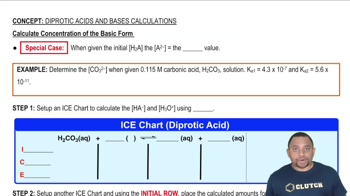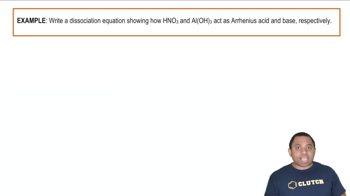Calculate the [H3O+] and pH of each polyprotic acid solution. b. 0.350 M H2C2O4
Ch.17 - Acids and Bases

Chapter 17, Problem 113
Is this question correctly formulated? If so, could you provide it as is; if not, modify it as needed and return it in JSON format: Calculate the concentration of all species in a 0.500 M solution of H2SO3.
 Verified step by step guidance
Verified step by step guidance1
insert step 1: Understand that H2SO3 is a diprotic acid, meaning it can donate two protons (H+ ions) in solution.
insert step 2: Write the dissociation equations for H2SO3. The first dissociation is H2SO3 ⇌ H+ + HSO3^-. The second dissociation is HSO3^- ⇌ H+ + SO3^2-.
insert step 3: Use the given initial concentration of H2SO3 (0.500 M) and set up an ICE (Initial, Change, Equilibrium) table for each dissociation step to track the changes in concentration.
insert step 4: Apply the equilibrium constant expressions for each dissociation step. For the first dissociation, use Ka1 = [H+][HSO3^-]/[H2SO3]. For the second dissociation, use Ka2 = [H+][SO3^2-]/[HSO3^-].
insert step 5: Solve the equilibrium expressions simultaneously to find the concentrations of all species: [H2SO3], [HSO3^-], [SO3^2-], and [H+].
Key Concepts
Here are the essential concepts you must grasp in order to answer the question correctly.
Concentration
Concentration refers to the amount of a substance (solute) present in a given volume of solution. It is commonly expressed in molarity (M), which is moles of solute per liter of solution. Understanding concentration is crucial for calculating the amounts of different species in a solution, especially in acid-base chemistry.
Recommended video:
Guided course

Calculate Concentration of the Basic Form
Dissociation of Acids
Dissociation of acids involves the process by which an acid releases protons (H+) into a solution. For weak acids like H2SO3 (sulfurous acid), this process is not complete, and the equilibrium between the undissociated acid and its ions must be considered. This concept is essential for determining the concentrations of all species in the solution.
Recommended video:
Guided course

Acid-Base Dissociation Example
Equilibrium Constant (Ka)
The equilibrium constant (Ka) quantifies the extent of dissociation of a weak acid in solution. It is defined as the ratio of the concentration of the products (ions) to the concentration of the reactants (undissociated acid) at equilibrium. Knowing the Ka value for H2SO3 allows for the calculation of the concentrations of all species present in the solution.
Recommended video:
Guided course

Equilibrium Constant K
Related Practice
Textbook Question
Textbook Question
Calculate the [H3O+] and pH of each polyprotic acid solution.
a. 0.125 M H2CO3
Textbook Question
Calculate the [H3O+] and pH of each polyprotic acid solution.
b. 0.125 M H3C6H5O7
Textbook Question
Calculate the concentration of all species in a 0.155 M solution of H2CO3.
Textbook Question
Calculate the [H3O+] and pH of each H2SO4 solution. At approximately what concentration does the x is small approximation break down?
a. 0.50 M b. 0.10 M c. 0.050 M
Textbook Question
Consider a 0.10 M solution of a weak polyprotic acid (H2A) with the possible values of Ka1 and Ka2 given here.
a. Ka1 = 1.0 × 10–4; Ka2 = 5.0 × 10–5
Calculate the contributions to [H3O+] from each ionization step. At what point can the contribution of the second step be neglected?
